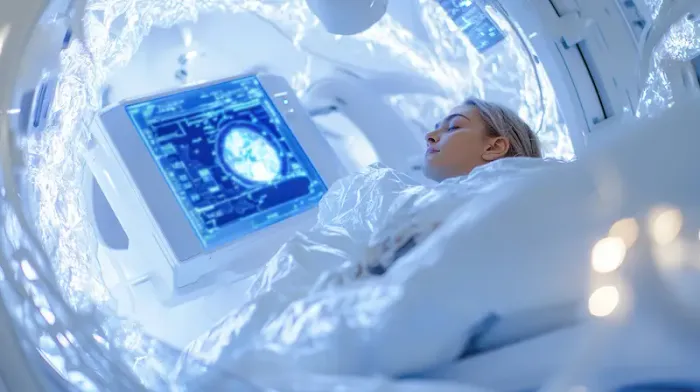Your Guide to the New 15 Silent MRI: A Calmer Scan Experience
Know about silent MRI, what it is, how it works, 15 key benefits, what to expect, safety and effectiveness concerns and more.

Written by Dr. M L Ezhilarasan
Reviewed by Dr. Rohinipriyanka Pondugula MBBS
Last updated on 7th Oct, 2025

Introduction
For many, the prospect of an MRI scan can be daunting. The combination of a confined space and the loud, repetitive knocking sounds, often compared to a jackhammer or an industrial machine, can trigger significant anxiety and claustrophobia. This discomfort sometimes leads patients to postpone necessary diagnostic procedures, potentially delaying crucial medical care. By drastically reducing the acoustic noise generated during the scan, it offers a viable solution for children, anxious adults, and anyone sensitive to loud noises. This guide will walk you through everything you need to know about this groundbreaking technology—how it works, its profound benefits, what to expect during a procedure, and who stands to gain the most from a quieter, more comfortable scan.
What is a Silent MRI and How Does it Work?
A silent MRI isn't completely silent, but it represents a monumental leap in noise reduction. While a traditional MRI can produce noise levels of 110 decibels or more (equivalent to a rock concert), a silent MRI operates at around 70-80 decibels—similar to the background hum of a washing machine or a vacuum cleaner in another room. This makes it possible to have a conversation or listen to music comfortably during the scan.
Consult a Top General Practitioner for Personalised Advice
The Science Behind the Silence: Moving Beyond the Jackhammer
The loud noises in a traditional MRI are caused by the gradient coils. These coils are essential components that create varying magnetic fields to pinpoint the location of signals from your body's atoms. As rapid electrical currents pulse through these coils inside the powerful main magnet, they vibrate violently, producing the characteristic banging and buzzing. The new silent MRI technology addresses this fundamental source of the noise.
Acoustic Reduction Technology: More Than Just Software
The "silent" feature is achieved through a combination of hardware and software innovations, often referred to as Acoustic Reduction Technology. This isn't just about playing music louder. It involves:
1. Reduced Gradient Switching: The system uses sophisticated software to reshape the electrical pulses sent to the gradient coils, making their transitions smoother and less abrupt. This directly reduces the force of the vibrations.
2. Advanced Coil Design: The physical design of the gradient coils is optimised to dampen vibrations. They may be housed in special sound-dampening materials or built with new architectures that minimise the amplification of sound.
3. Active Noise Cancellation: Some systems, like parts of the 15 Silent MRI portfolio, incorporate technology similar to noise-cancelling headphones, which emit sound waves that destructively interfere with the residual noise from the machine.
Key Benefits of the Silent 15 MRI System
The advantages of undergoing a silent MRI extend far beyond simple comfort. They have tangible benefits for both patients and clinicians.
A Game-Changer for Pediatric Patients
Getting a young child to lie completely still inside a loud, tunnel-like machine is incredibly challenging. Often, it requires sedation or general anaesthesia, which carries its own risks. The silent MRI system is transformative for pediatric imaging. The dramatically reduced noise and the ability to watch a movie or listen to a story through special headphones can keep a child calm and still, often eliminating the need for sedation.
Relief for Adults with MRI Anxiety and Claustrophobia
MRI-related anxiety is a common issue. The quiet environment of a silent scan significantly lowers stress levels for anxious and claustrophobic patients. A calmer patient is less likely to move, which is critical for obtaining clear, blur-free images. This makes the process more efficient and improves the likelihood of a successful diagnostic outcome on the first attempt.
Enhanced Image Quality for Specific Diagnoses
For certain delicate studies, particularly of the brain and inner ear, patient movement—even from flinching at a loud noise—can degrade image quality. The serene environment of a silent MRI allows for exceptionally sharp images in areas like the auditory cortex or for patients with tinnitus, where traditional MRI noise can interfere with the diagnostic data.
What to Expect During Your Silent MRI Scan
If you're scheduled for a silent MRI, the preparation is largely the same as for a traditional scan. You'll still need to remove all metal objects and inform the technologist of any implants or pregnancy.
Preparation: Similar, Yet More Comfortable
The key difference is the enhanced comfort from the start. You will be offered headphones through which you can listen to your choice of music or simply experience the significantly quieter ambient sound of the machine.
The Scanning Process: Hearing the Difference
Once the scan begins, you will notice the difference immediately. Instead of loud, jarring knocks, you will hear a soft, humming, or whirring sound. The technologist will be able to communicate with you more easily between sequences. The entire experience is designed to be less isolating and more manageable. If you have a history of severe anxiety, it's always best to discuss it with your doctor. They can provide guidance, and if needed, you can consult a specialist online with Apollo24|7 to manage pre-scan nerves.
Who is the Ideal Candidate for a Silent MRI?
While anyone can benefit from a quieter, more comfortable scan, the new silent MRI is particularly recommended for:
1. Children of all ages.
2. Adults with known anxiety or claustrophobia.
3. Individuals with sensory processing disorders (e.g., autism spectrum disorder).
4. Patients requiring frequent MRI monitoring (e.g., for multiple sclerosis or cancer), as it reduces the cumulative stress of repeated scans.
5. Anyone who simply prefers a more comfortable medical experience.
Addressing Common Concerns: Safety and Effectiveness
The concerns regarding safety and effectiveness include:
Is the Silent Scan as Accurate as a Traditional MRI?
This is the most important question. Extensive clinical studies have shown that the diagnostic accuracy of a silent MRI is equivalent to that of a conventional MRI for the vast majority of clinical applications. The core magnetic field and imaging principles remain unchanged; only the noise-producing gradient pulses are optimised.
Are There Any Additional Risks?
There are no additional risks associated with a silent MRI. It is just as safe as a traditional MRI. The powerful magnetic field is still present, so all standard safety precautions regarding metal objects must be strictly followed.
How to Find a Silent MRI Facility Near You?
The 15 Silent MRI technology is becoming more widely available, but it is not yet universal. The best way to find a facility near you is to:
1. Ask Your Doctor: Your referring physician will often know which imaging centres have the latest technology.
2. Call Imaging Centres Directly: Contact major hospitals and private imaging centres in your area and specifically ask if they offer "silent MRI" or "quiet MRI" scans.
3. Check Manufacturer Websites: Companies like Siemens, GE, and Philips have tools to locate healthcare providers using their specific technologies (e.g., Silent Scan).
Conclusion
The advent of the new 15 Silent MRI system marks a significant step forward in patient-centred care. By directly addressing the primary source of discomfort, the overwhelming noise this technology is making, essential diagnostic imaging becomes accessible and tolerable for a wider range of patients. If you or a loved one has been avoiding an MRI due to fear or anxiety, discussing the option of a silent MRI with your doctor could be a transformative conversation. It represents a quieter, calmer, and more compassionate future for medical diagnostics. If your doctor has recommended an MRI and you have concerns, you can always book a consultation online with Apollo24|7 to discuss your options and get your questions answered.
Consult a Top General Practitioner for Personalised Advice
Consult a Top General Practitioner for Personalised Advice

Dr. Shubham Chauhan
General Practitioner
4 Years • MBBS
Lucknow
Apollo 24|7 Clinic - Uttar Pradesh, Lucknow

Dr Summaiya Banu
General Practitioner
8 Years • MBBS
Hyderabad
Apollo 24|7 Clinic, Hyderabad
(225+ Patients)

Dr. Syed Ismail Ali
General Practitioner
7 Years • MBBS
Hyderabad
Apollo 24|7 Clinic, Hyderabad

Dr. Rajib Ghose
General Physician/ Internal Medicine Specialist
25 Years • MBBS
East Midnapore
VIVEKANANDA SEBA SADAN, East Midnapore

Dr. Tapabrata Ray
General Physician/ Internal Medicine Specialist
4 Years • MBBS,DGM,CPMeC,ACMDC
Kolkata
MCR SUPER SPECIALITY POLY CLINIC & PATHOLOGY, Kolkata
Consult a Top General Practitioner for Personalised Advice

Dr. Shubham Chauhan
General Practitioner
4 Years • MBBS
Lucknow
Apollo 24|7 Clinic - Uttar Pradesh, Lucknow

Dr Summaiya Banu
General Practitioner
8 Years • MBBS
Hyderabad
Apollo 24|7 Clinic, Hyderabad
(225+ Patients)

Dr. Syed Ismail Ali
General Practitioner
7 Years • MBBS
Hyderabad
Apollo 24|7 Clinic, Hyderabad

Dr. Rajib Ghose
General Physician/ Internal Medicine Specialist
25 Years • MBBS
East Midnapore
VIVEKANANDA SEBA SADAN, East Midnapore

Dr. Tapabrata Ray
General Physician/ Internal Medicine Specialist
4 Years • MBBS,DGM,CPMeC,ACMDC
Kolkata
MCR SUPER SPECIALITY POLY CLINIC & PATHOLOGY, Kolkata
Frequently Asked Questions
1. Is a silent MRI completely silent?
No, it is not completely silent. The term 'silent' is relative. The noise is reduced by up to 99%, changing the sound from loud, disruptive banging to a soft, background hum or whir, making it much more comfortable.
2. Does a silent MRI take longer than a regular MRI?
Scan times are generally comparable. In some cases, a silent MRI might be slightly faster because there is less need to repeat sequences due to patient movement, making the process more efficient overall.
3. Is the cost of a silent MRI higher?
There may be a slight premium for a silent MRI scan due to the advanced technology involved. The cost can vary depending on the facility and your location. It's best to check with your insurance provider and the imaging centre for specific pricing.
4. Can a silent MRI be used for all types of scans?
While silent MRI technology is excellent for the most common scans, especially neurological and musculoskeletal imaging, some highly specialised sequences may still require conventional scanning modes. Your radiologist will determine the best protocol for your specific diagnostic needs.
5. What if I am claustrophobic but still feel anxious in a silent MRI?
The open design of the 15 Silent MRI system, combined with the noise reduction, helps most claustrophobic patients. However, if you have severe claustrophobia, discuss your options with your doctor. They may still recommend a mild sedative to help you relax during the procedure.
.webp)



 Test.webp)